Chapter 30. Northwestern University: Information Commons
What Is It?
Northwestern University is a private doctoral research institution just north of Chicago with a full-time enrollment of 15,700 students. Northwestern University's Information Commons, or InfoCommons, is a new type of learning space that exemplifies technology and space design working to encourage and enhance research and collaboration. The library already supports spaces for teaching and learning. The InfoCommons does not replace these spaces; instead, it provides modular furniture, a group project room, staffing support, and a new sense of purpose for students. As a joint venture between the library and Northwestern University Information Technology (NUIT), it promotes cross-departmental cooperation.
During the design phase, groups providing input considered factors such as the ability for different sizes of groups to work and feel comfortable; the flexibility of the space; and the relationship of the InfoCommons to already established departments within the library and Academic Technologies (a division of NUIT). The 5,100-square-foot InfoCommons offers a variety of configurations: individual workstations, group presentation areas, booths for group study, and a small-group project room, permitting students to choose different level of interactions with their peers in a technologically rich yet informal environment.
What Happens Here?
The InfoCommons provides a technologically rich and welcoming environment that supports and encourages many new practices in scholarship, teaching and learning, and electronic publishing. It offers a solution to the problems that students often face when trying to work or study in an area that lacks adequate technology, is physically uncomfortable, or makes collaborative work difficult. Within the InfoCommons, students write class papers; work collaboratively on class projects with peers (onsite or virtually); hold impromptu meetings near their workstations; e-mail friends, professors, and others; and use the location as a first stop for their research needs. The workstations, booths, presentation stations, project room, and flexible furniture make this a space where people and technology comfortably intersect.
Group Work
The InfoCommons supports both formal and informal groups. The furniture arrangement allows students to work comfortably by themselves, but its flexibility encourages small groups to gather around a single workstation by moving chairs or monitors. Many larger groups find the two presentation stations convenient for working on class projects. (See Figure 1.)
Figure 1. Flexible Furniture for Group or Individual Study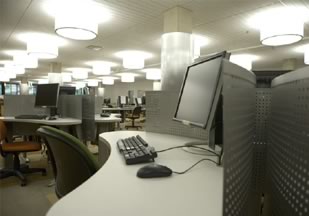
The project room supports more formal work. It is scheduled by groups that need a slightly different setting for presentations or discussions, while still feeling they are part of the InfoCommons. For example, teaching assistants regularly schedule the room for review sessions with their classes.
How Is Technology Used?
The InfoCommons contains more than 50 high-end computers, wireless access, and data ports at strategic locations. Students have the option of printing to a color or two black-and-white printers as well as saving their work online for easy access at a later date.
General area: Students engage in individual or spontaneous group work. The furniture setup enables easy collaboration. Three, four, or five students sitting together in a booth can use the resident computer or connect their laptops to do joint work; many students use available tables for wireless laptops. (See Figure 2.)
Figure 2. Modular Furniture and Ample Work Space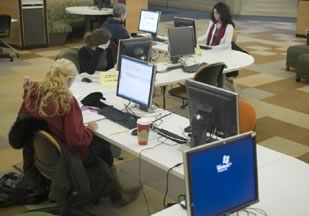
The 52-inch plasma screens work with a resident computer or a connected laptop. They face into the general area and are available for group projects, papers, and presentations. The large screens are valued both for group collaboration and individual use. (See Figure 3.)
Figure 3. Plasma Screens
Small group project room: The state-of-the-art technology in the small group project room includes two digital whiteboards, a projector, a computer, comfortable chairs, and network connections for interactive presentations, projects, and study sessions. Students can also connect a laptop and turn the whiteboard into a presentation screen, allowing them to combine images and annotation that they can ultimately print (in color, if they choose) or save as separate files to be shared or reviewed later.
What Makes the Space Successful?
A number of features contribute to the area's success.
No boundaries: No barriers separate the InfoCommons from the main library corridor, yet the space successfully creates small enclaves of privacy in a completely open area. The InfoCommons provides spaces that allow students to work together-to solve problems, exchange ideas, and work collaboratively. The casual passerby can view activity and easily become part of it. Particularly in the booths (see Figure 4) and at the presentation stations, students remain unaware-or perhaps uncaring-of passersby, opening their lives and work to all who might see.
Figure 4. Enclaves of Privacy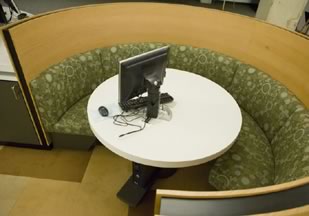
Challenging and changing cultures: The concept of a learning space such as the InfoCommons can challenge those with traditional views of "learning" and "space." Library staff accustomed to following long-established routes to their offices and departments through the busy InfoCommons, for example, now view it differently. The high visibility of the area's social and learning capability is often a new idea, especially for visitors and prospective students (who embrace it with enthusiasm).
A social space: The InfoCommons is a first stop for many students entering the library. (See Figure 5.) It offers a welcoming social environment where they engage in independent inquiry, participate in small group interactions, or sip coffee from the nearby café.
Figure 5. A First Stop for Many Students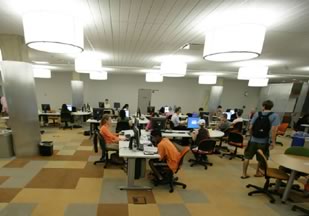
Informality: The project room was initially envisioned as a glassed-off formal conference room, complete with a large table surrounded by chairs, distinguishing it from the rest of the InfoCommons. By contrast, the room's actual success can be attributed to the shift away from this planned formality to a relaxed setting rich in technology that blends unobtrusively, versatile and comfortable chairs, and a surprisingly low "coffee table" with a wireless keyboard, data, and power ports-at the right height for feet. (See Figure 6.)
Figure 6. Group Project Room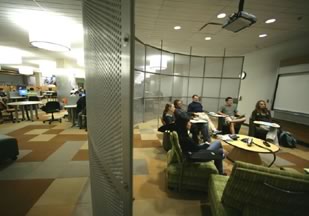
Staffing: Administratively, the InfoCommons is part of the library's Reference Department, but joint staffing is provided by Academic Technologies, ensuring that assistance (by students or staff) for research, technology, and other needs is always available.
What Principles Were Behind the Design?
The vision of the InfoCommons was that of a learning environment to support the growing institutional focus on interdisciplinary programs for undergraduates. The technologically rich InfoCommons supports different needs and priorities, encourages collaborative learning, and is sufficiently flexible to accommodate changing requirements. David Bishop, the university librarian, said,
If academic libraries are to remain vital as places, students must want to use them, even though they can access electronic resources remotely. The Information Commons was conceived as a focus for undergraduate activity. It provides a facility that enables and encourages collaboration, and is a place where students can get answers to questions about both library resources and computers. Student needs and preferences will undoubtedly change over time, so a key to the success of the Information Commons will be to reinvent it as needed.
What Is Unique or Noteworthy?
Four characteristics distinguish the InfoCommons:
- The whole is greater than the sum of its part(ner)s. The InfoCommons is just one example of continuing partnerships between Academic Technologies and the library that cross many boundaries. The vision of the InfoCommons was to move beyond traditional computer labs and computer spaces. The result has been a successful partnership that enhances the undergraduate experience.
- Spaces evolve. Digital resources, new programmatic needs and directions, and advances in learning theory all form part of our changing environment. As these elements emerge and develop, reflecting changing characteristics of the institution, the InfoCommons will continue to evolve and redefine its role.
- Location, location, location contributes to the site's success. The InfoCommons is a destination of choice for students. Viewing it as more than "the library," they value its welcoming feel, its casual yet supportive atmosphere, its dynamism and energy, and the exceptional technology and resources that it provides as they engage in learning.
- The InfoCommons has been replicated elsewhere. The overwhelming acceptance and success of the InfoCommons as a unit and also as an innovative learning space has encouraged the university library and Academic Technologies to replicate similar spaces and concepts elsewhere in specialized or branch libraries.
About the Authors
Bob Davis is the associate director of academic technologies, Northwestern University Information Technology, at Northwestern University.
Denise Shorey is the head of the reference department, Northwestern University Library, at Northwestern University.